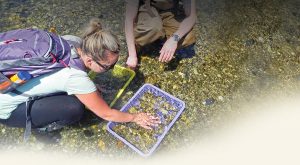Larval Exchange in Olympia Oyster Recovery
Recovery of the Native Olympia Oyster, Ostrea lurida, in Northern Puget Sound: Measuring the Larval Import to and Export from a Restored Subpopulation
Researchers use seawater chemistry to trace larval exchanges between Olympia oyster populations.
